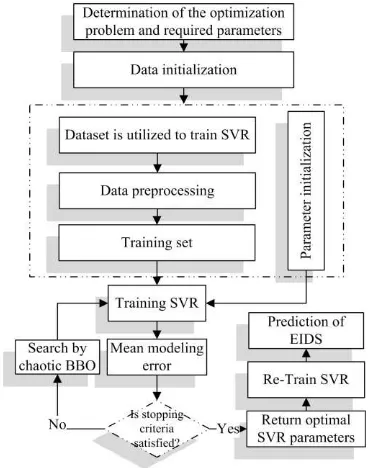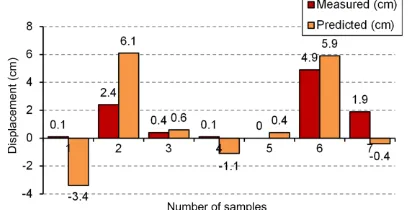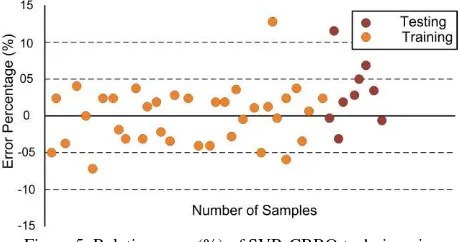AN EFFECTIVE HYBRID SUPPORT VECTOR REGRESSION WITH
CHAOS-EMBEDDED BIOGEOGRAPHY-BASED OPTIMIZATION STRATEGY FOR
PREDICTION OF EARTHQUAKE-TRIGGERED SLOPE DEFORMATIONS
Ali Asghar Heidari a,*, Simin Sadat Mirvahabia, Saeid Homayounib
a School of Surveying and Geospatial Engineering, College of Engineering, University of Tehran, Iran (as_heidari, mirvahabi.s)@ut.ac.ir
b Department of Geography, Environmental Studies and Geomatics, University of Ottawa, Canada [email protected]
KEY WORDS: Earthquake; Support Vector Regression; Biogeography-based Optimisation; Displacement;Hazard ABSTRACT:
Earthquake can pose earth-shattering health hazards to the natural slops and land infrastructures. One of the chief consequences of the earthquakes can be land sliding, which is instigated by durable shaking. In this research, an efficient procedure is proposed to assist the prediction of earthquake-originated slope displacements (EIDS). New hybrid SVM-CBBO strategy is implemented to predict the EIDS. For this purpose, first, chaos paradigm is combined with initialization of BBO to enhance the diversification and intensification capacity of the conventional BBO optimizer. Then, chaotic BBO is developed as the searching scheme to investigate the best values of SVR parameters. In this paper, it will be confirmed that how the new computing approach is effective in prediction of EIDS. The outcomes affirm that the SVR-BBO strategy with chaos can be employed effectively as a predicting tool for evaluating the EIDS.
* Corresponding author
1. INTRODUCTION
Earthquake can pose earth-shattering health hazards to the natural slops and land infrastructures. Dislocation of earthquake can cause intense and large destruction in earth and its structures. Earthquakes with high magnitudes can cause far-reaching land sliding on sensitive slopes (Keefer, 1984, Jibson, 1993). One of the leading consequences of the earthquakes can be land sliding, which is instigated by durable shaking. Ground motion, material strength and slope configuration has an effect on creating landslides from particular slopes (Ambraseys, 1995). Prediction of triggered displacements is a decisive requirement in hazard management. Effective planning after hazard can be completed based on such a predictive analysis. In this theme, there is requirement for developing more competent approaches for attaining more accurate predictive results for this problem (Sakellariou et al., 2005). The support vector regression (SVR) is usually known as an operative data mining structure (Lu et al., 2009). In each operation, certain parameters ought to be selected by user specifically. The overall competences of the SVR are related to its preliminary parameters (Lu et al., 2009). Inaccurate outcomes can be obtained by inappropriate set of primary parameters. Hence, the prerequisite parameters of SVR can be determined fittingly by using proper heuristic mechanisms.
Up to 2015, many nature inspired procedures have been established to tackle optimization operations. Biogeography-based optimization (BBO) is a robust well-established evolutionary strategy announced in 2008 (Simon, 2008). It mimics the relocation of wildlife amongst diverse islands and habitats on earth (Simon, 2008). Since 2008, BBO has been implemented to treat various complex tasks such as sensor selection, groundwater detection and classification (Panchal et al., 2009). Up to now, BBO has also revealed efficient
performance on solving spatial tasks on geosciences as well. In
BBO, any solution should be seen as a “habitat” with some
suitability index (HSI) (Simon, 2011). Solutions with superior indexes will share their features with others. However, this algorithm still has a main problem: immature convergence to regional elites. To relive this problem, some modifications are required. Hence, BBO can be hybridized with chaos. Chaos can be defined as unpredictable motions observed in dynamical systems (Heidari et al., 2015). In this extent, several works showed that chaos paradigm can improve the efficiency of the algorithms.
In this paper, an effective methodology is proposed to assist the prediction of earthquake-originated slope displacements (EIDS). Hybrid SVM-BBO strategy is implemented to predict the EIDS. For this purpose, first, chaos paradigm is combined with initialization of BBO to boost the exploration and exploitation capacity of the basic optimizer. Then, chaotic BBO (CBBO) is used as the searching scheme in order to investigate the best values of SVR parameters. In the rest of paper, it will be demonstrated that how the new computing approach is effective in prediction of EIDS.
The organization of this article is as: support vector regression (SVR) is introduced in Section 2; BBO and chaotic BBO will be presented in Section 3; the tuning of SVR by CBBO is expressed in Section 4. Prediction of EIDS is done in Section 5. The results are reported in Section 6; conclusions are specified in latest Section.
2. SUPPORT VECTOR REGRESSION (SVR)
Support vector machines (SVMs) announced in 1995 as a machine technique that have capabilities in prediction and simultaneous error minimization (Vapnik, 1995). It has two main categories including support vector regression and support vector classification (SVC) (Basak, 2007). Fitting a linear
function to the feature space with least suitable complexity and mapping primary data into higher-dimensional space are the principle concepts of SVR (Basak, 2007). For reducing correspondingly. To obtain the b, w values, the subsequent term should be minimized (Vapnik, 1995):
2
1
(1 / 2) ( / ) li i ( i) ,
R w C L
y f x (2)Loss function in SVR (Vapnik, 1995) performs ε-insensitive:
0 ( )
The reformulation of this problem can be arranged as:
* * *
parameter that specifies trade-off between weight vector and approximation error (Vapnik, 1995). The best linear hyper
input data onto the feature space in nonlinear regression. It can be expressed as follow:
( , ) T( ) ( ), , 1,..., ,
i i j
K x x x x i j l (9) where the right side of the equation are the projection of the xi
and xj to the space of feature, correspondingly. In this work,
Biogeography based optimization (BBO) algorithm can be regarded as a relatively well-established, robust meta-heuristic approach that has been implemented to tackle several complex tasks (Pan et al., 2011). BBO is originated from the theory of island biogeography introduced by Simon (2008). The BBO optimizer exposes specific advantages over the old-fashioned calculus-based problem solvers. The latter typically require some mathematical features like differentiability and/or convexity. But, BBO is founded on stochastic explorative mechanisms (Simon, 2011). It breeds an updated candidate by observing all reachable solutions. BBO contains two main thoughts: mutation and migration (Simon, 2011). First stage is designed for evaluating each individual of populations and second stage is developed for computing migration to realize
overall minimum. In BBO technique, the following items should be considered:
Two main component of each habitat are emigration rate λ and immigration rate µ (Simon, 2011). A better solution should where Smax indicates the largest possible number of species,
S shows the number of species,
E specifies the maximum emigration rate,
I symbolizes the maximum rate of immigration. One user-defined parameter is utilized to update each solution. For improving the exploitation capability of BBO, each bad solution should collect additional beneficial information from the better solutions (Simon, 2011).
Considering the mentioned operators, the BBO technique can be performed through the succeeding phases (Simon, 2011): Step 1: Preparing the prerequisite BBO parameters. Step 2: Initialize the stochastic group of habitats
Step 3: For every habitat, the emigration and immigration rate and the HSI to the number of species should be calculated. Step 4: Afterward, emigration and immigration are employed to regulate each non-elite habitat, randomly.
Step 5: Before recalculating each HSI, first, the probability of each habitat species should be updated and non-elite habitat should be mutated according to its probability.
1 1 Step 6: Back to Step 3 for the succeeding repetition. This loop should be ended with regard to a prearranged condition. 3.1 Chaotic BBO (CBBO)
In general, chaos can be pronounced as some complex unpredictable waves in natural systems (Heidari et al., 2015). In this extent, several works showed that chaos paradigm can improve the efficiency of the meta-heuristics. Chaotic pattern also can enhance the diversification and intensification mechanism of these methods (Heidari et al., 2015). For this work, chaos paradigm is combined with initialization of BBO to boost the diversification and intensification capacity of the basic BBO optimizer. Analogous to other metaheuristics, there are two principal phases which are noticeable in BBO optimizer: initialization and breeding new generations. Population initialization can be regarded as an effective stage in BBO since it can affect the fineness values of the outcomes. In basic BBO,
initialization is performed in a random manner. As the chaotic signals characterize chaos-based behaviour, a generation of chaos embedded BBO can heighten both exploration and exploration. Hence, chaos theory can also enhance the efficiency of the robust BBO by refining the diversity of the solutions during more generations (Heidari et al., 2015). In this article, the logistic signal is utilized in the initialization step of CBBO. First, a chaotic signal should be selected. In these simulations, the logistic map is implemented in the first steps of the BBO. The logistic map can be expressed as follows (Heidari et al., 2015):
chaotic initialization, the next equation is applied instead of random initialization. decision variables and chaos(.) indicates an utilized chaos-based signal as a recursive function.
In addition, a chaotic immigration mechanism is proposed. In this process, the new equation is designed as follows:
In this equation, d displays the dimension; the first term shows the ith solution in tth repetition, the next term symbolizes the jth
In dynamic operation, the characteristics of every new solution should be dynamically determined based on a combination of its pervious properties and another solution. In the BBO, each solution is only calculated based on the other members. This operation not only can enhance the exploration potential of the BBO, but also can relive the early convergence problem of the conventional optimizer.
4. SVR TUNING BY CHAOS EMBEDDED BBO
The learning parameters of the SVR have a great influence on its generalization capability. Determining the best set of these parameters is usually a hard task with regard to the space model. Tuning of these values by exhaustive search approaches cannot be usually an efficient task with respect to the passed time. In addition, some of them cannot convergence to the optimal point. Until now, some of works employed GA, ACO and HS to determine the SVR parameters (Saygili et al., 2008). In this article, the new CBBO is developed for tuning of SVR to enhance the efficiency of required SVR learning process. The structure of the SVR-CBBO is represented in Figure 1:
Figure 1. The SVR-CBBO flowchart 45 cases. 36 test cases of this data are employed for training and 9 cases are utilized for testing. A software package was implemented in MATLAB to evaluate induced deformations for
r = 5, 10, 15 (km) and M=6, 6.5 and 7 (Richter). The data in (Ferentinou et al., 2007) includes information for 45 slopes, were u can be obtained by using the subsequent equations. The formulation of the present test case is about these parameters: acceleration (Ferentinou et al., 2007).
1/3 stage guarantees that the utilized raw records are faultlesslyappropriate for modelling. The employed dataset are normalized
(minimum) values of input, correspondingly. To substantiate the proposed approach, 4 statistical criteria were preferred to measure the accurateness including MAPE, MSE, VAF, RMSE and R2. These values may be expressed as:
Here, the performance of CBBO is examined in detail. For this paper, proposed approach is realized by using MATLAB R2012a (7.14) on a T6400@4 GHz Intel Core (TM) 2 Duo processor PC with 4 GB RAM. For this test, CBBO procedure is experienced for 30 trials with 1.00E+02 iterations. In CBBO, the population size is 30; habitat adjustment probability is 1; immigration chance is 0.7; step size is 1; maximum of I and E
is1 and mutation possibility is 0.007.
In present article, an effective hybrid SVR-CBBO is recommended based upon MATLAB to predict the EIDS. 20-fold cross-validation simulations are utilized for training task with SVR-CBBO in order to to realize more consistent outcomes. The attuned parameters with highest precision are recorded as the best suitable values. Then, the optimal factors are employed to train the SVR structure. The best values explored by the CBBO are reflected in Table 1.
SVR-CBBO Outcomes 1.8101 1842.108 0.0289
Table 1. The best SVR parameters estimated by the proposed CBBO approach
The calculated MAPE, RMSE, VAF, MSE, R2and values for
training datasets demonstrate the learning competence of data samples, while the outcomes of examined dataset expose the generalization capability and the robustness of the scheme modelling approaches. It is recognized that the model learning potential is influenced by the embedded complexity in the system designation. The SVR-CBBO results are demonstrated in Figure 2 and Figure 3 in comparison with the measured values of 45 data samples after training and testing stages.
Figure 2. Comparison of predicted and measured deformation for training first 18 data samples
From Figure 2, it can be observed that the SVR-CBBO can attain outcomes with an appropriate precision compared to the first 18 actual data (1-18).
Figure 3. Judgment amongst predicted and measured deformation for training second 18 data locations From Figure 3, it can be observed that the SVR-CBBO can attain outcomes with a proper accuracy compared to the second 18 actual data (18-36). The results for testing dataset are also shown in Figure 4.
Figure 4. Judgment among predicted and measured deformation for testing data locations
Performance investigation of SVR-CBBO for forecasting displacement is exposed in Table 2.
Data R2 MSE RMSE VAF MAPE
training 0.9911 0.00071 0.0247 99.68 4.1185 test 0.9321 0.01423 0.1198 84.37 81.710
Table 2. SVR-CBBO Performance for prediction of deformation
The statistical outcomes stated in Table 2 affirm the high performance of the suggested mechanism. Based on the results,
SVR-CBBO is competence to be utilized efficaciously to tackle EIDS prediction task. For more investigations, the percentage of relative error is exposed in Figure 5.
Figure 5. Relative error (%) of SVR-CBBO technique in displacement prediction
It can be recognized that the exposed error for most of the samples are located in the (-10%, +10%) interval, which can be considered as a satisfactory precision. These outcomes also affirm that the premature convergence concern can be mitigated significantly by the suggested mechanism.
7. CONCLUSIONS
Earthquake can create earth-shattering hazards to the natural slops and terrestrial structures. In this paper, an effective methodology is proposed to assist the EIDS prediction task. Hybrid SVR-CBBO strategy is realized to forecast the EIDS. For this intention, first, chaos patterns were combined with operations of BBO to boost the exploration and exploitation capability of the BBO. Then, chaotic BBO (CBBO) was utilized as the searching tool to explore the best values of SVR parameters. Based on the results, it was confirmed that how the new CBBO method is effective in prediction of EIDS. The results confirm that the new CBBO technique is competent and effective to improve the SVR solutions. The outcomes affirm that the SVR-CBBO strategy can be employed effectively as a predicting tool for assessment of the EIDS. To the best of our knowledge, this research is the first implementation of chaotic BBOfor prediction of EIDSin the professional literature. For future works, CBBO can be implemented and validated to tackle other spatial optimization tasks.
REFERENCES
Ambraseys N, Srbulov M., 1995. Earthquake induced displacements of slopes. Soil Dym Earthquake Eng. 14, pp.59-71.
Aydin, M.E., Fogarty, T.C., 2004. A Distributed Evolutionary Simulated Annealing Algorithm for Combinatorial Optimization Problems. J. of Heuristics 10, pp.269-292. Basak, D., Pal, S., Patranabis, D.C., 2007. Support vector regression, Neural Information Processing - Letters and Review
11 (10), pp.51-75.
Ferentinou M, Sakellariou M., 2007. Computational intelligence tools for the prediction of slope performance,
Comput Geotech 34, pp.362-84.
Gunn SR., 1998. Support vector machines for classification and regression, ISIS Technical report, pp.14.
Heidari, A. A., Abbaspour, R. A. and Jordehi, A. R., 2015. An efficient chaotic water cycle algorithm for optimization tasks.
Neural Computing and Applications, doi: 10.1007/s00521-015-2037-2.
Jibson RW, 1993. Predicting earthquake-induced landslide displacements using Newmark's sliding block analysis.
Transport Res Record1, pp. 9-17.
Keefer DK., 1984. Landslides caused by earthquakes. Geolog Soci America Bull 95, pp. 406-21.
Lu, CJ., Lee, T. S. and Chiu, C. C., 2009. Financial time series forecasting using independent component analysis and support vector regression. Decision Support Systems 47(2), pp.115-125. Panchal, V., Singh, P., Kaur, N., Kundra, H., 2009. Biogeography based satellite image classification. International Journal of Computer Science and Information Security 6 (2), pp.269–274.
Sakellariou M., Ferentinou M., 2005. A study of slope stability prediction using neural networks. Geotech Geol Eng 24(3), pp.419–45.
Saygili G., Rathje E.M., 2008. Empirical predictive models for earthquake-induced sliding displacements of slopes. J Geotech Geoenvironm Eng 134, pp.790-803.
Simon, D., 2008, Biogeography-based optimization, IEEE Transactions on Evolutionary Computation 12 (6), pp. 702-713.
Simon, D., 2011. A probabilistic analysis of a simplified biogeography-based optimization algorithm. Evolutionary computation19(2), pp.167-188.
Vapnik, V., (1995). The Nature of Statistical Learning Theory. Springer-Verlag, New York.
Vapnik, V., Golowich, SE. Smola, A, 1997. Support vector method for function approximation, regression estimation, and signal processing. Adv Neural Inform Process syst. 1, pp. 281-287.


